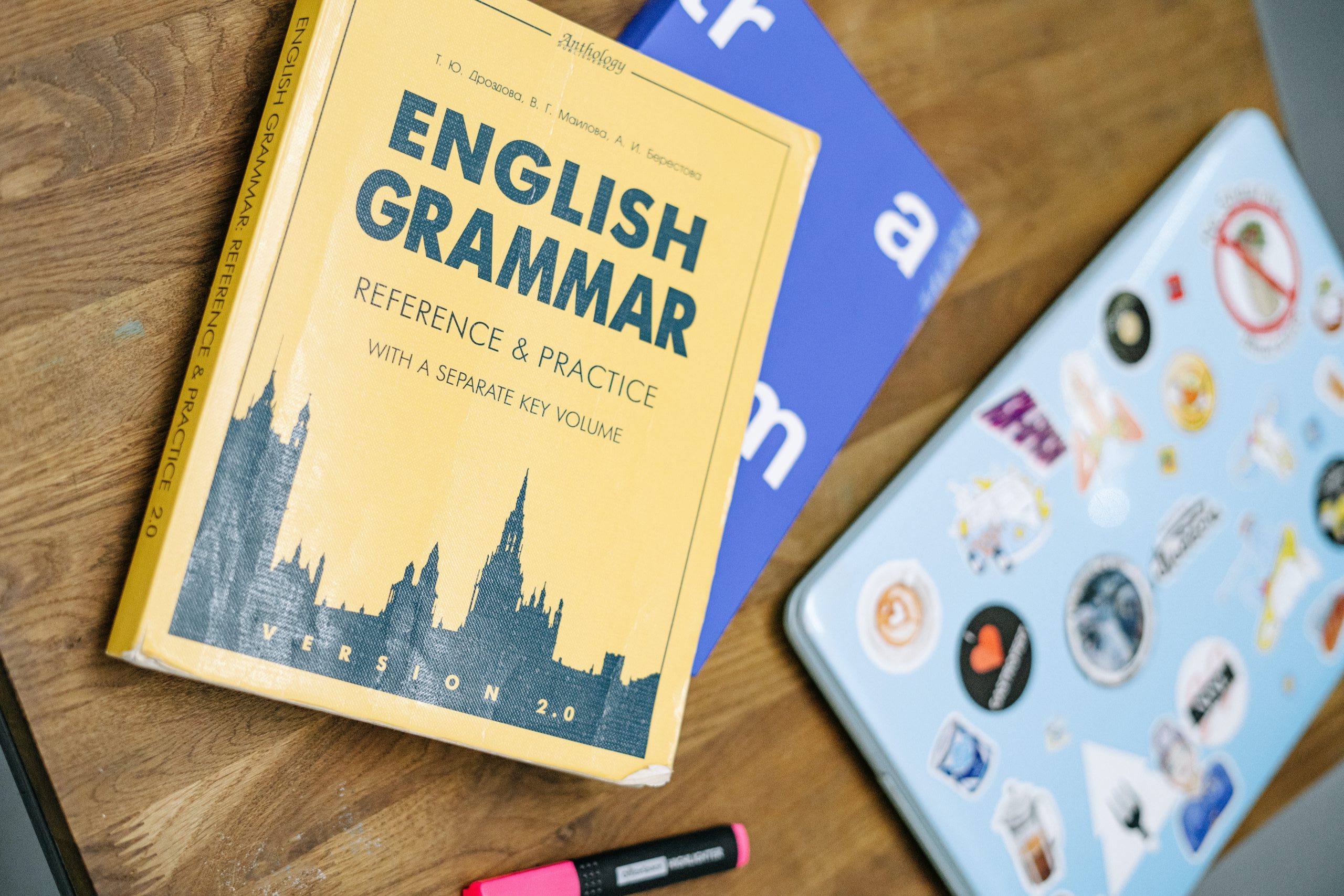
In the era of rapid communication, the ability to convey your thoughts clearly and effectively is vital. English, being a globally recognized language, serves as a universal medium for various forms of communication. Learning English grammar, the fundamental structure of the language, equips you with the skills to craft messages that are both clear and precise. It fosters better understanding and collaboration, enhancing personal and professional communication.
Are you here because you’re preparing for an English language exam? Check out this blogpost on: how to fully prepare for your English language exam or this one on choosing the right English certification for your career.
This blog post is aimed at anyone wishing to improve their basic English grammar. Understanding and applying English grammar correctly can pave the way for academic excellence, professional growth, and personal satisfaction. Let’s get started!
Chapter 1: Understanding the Parts of Speech
“Nouns”
Nouns are the building blocks of a sentence, representing people, places, things, or ideas. Understanding the different types of nouns – “proper, common, countable, uncountable,” and “collective” – is crucial for constructing meaningful sentences. For example, “The teacher (common noun) handed out books to the students (common noun) in the library (common noun).” Here we see nouns playing a crucial role in setting the context of the action being described.
“Pronouns”
Pronouns are words that can take the place of nouns, helping to avoid repetition and making sentences more concise. For instance, instead of saying, “John gave John’s book to John’s sister”, we can say, “John gave his book to his sister”. “Pronouns” come in various forms including personal “(I, you, he, she)”, demonstrative “(this, that)”, and relative “(who, which)”. Understanding the appropriate use of pronouns can lead to more fluid and elegant sentence structures.
Chapter 2: Building a Sentence
“Subject”
In a sentence, the subject is what the sentence is about, often indicating who or what is performing the action. Subjects can be simple, with just a noun or a pronoun, or compound, involving more than one noun or pronoun. For example, “The cat (simple subject) is sleeping” or “Sarah and John (compound subject) are traveling to Spain”.
“Predicate”
The predicate in a sentence provides information about what the subject is doing or what condition the subject is in. It often contains a verb and additional details that give more information about the subject. For instance, in the sentence, “The children are playing in the park”, “are playing in the park” is the predicate that tells us what the subject, “the children”, are doing.
“Object”
The object in a sentence is the entity that is affected by the action of the subject. It can be direct, receiving the action directly, or indirect, representing the recipient of the action. Understanding the role of objects can help in crafting sentences that convey clear and complete thoughts. For example, “She gave him (indirect object) a book (direct object)”.
“Complements”
Complements are words or groups of words that provide additional information about the subject or the object in a sentence. They help in completing the meaning of a sentence. For instance, in the sentence, “She is a renowned artist”, “a renowned artist” serves as a complement, giving more information about the subject “she”.
Chapter 3: Delving into Tenses
“Past Tense”
The past tense in English helps to express actions or states that occurred at a time before the present. There are various forms of past tense:
- “Simple Past”: Denotes completed actions in the past. E.g., “She visited Paris last year.”
- “Past Continuous”: Describes an action that was ongoing in the past. E.g., “We were watching a movie yesterday evening.”
- Past Perfect: Illustrates an action that occurred before another action in the past. E.g., “By the time she arrived, the train had already left.”
“Present Tense”
The present tense marks actions or states occurring in the current time. It has several forms:
- “Simple Present”: Indicates routine or habitual actions. E.g., “She walks to school every day.”
- “Present Continuous”: Describes actions that are happening now or around now. E.g., “They are eating lunch.”
- “Present Perfect”: Denotes actions that started in the past and continue in the present. E.g., “He has worked at the company for three years.”
“Future Tense”
The future tense forecasts actions or states that will happen at a later time. It includes various forms such as:
- “Simple Future”: Predicts actions that will happen in the future. E.g., “I will call you tomorrow.”
- “Future Continuous”: Describes ongoing actions that will take place in the future. E.g., “She will be traveling to London next week.”
- “Future Perfect”: Indicates actions that will be completed before another specified future time. E.g., “By 2025, we will have colonized Mars.”
“Continuous and Perfect Aspects”
Understanding the continuous and perfect aspects can further refine your grasp of tenses. These aspects, when combined with different tenses, provide a rich description of the time and state of actions:
- “Continuous Aspect”: Denotes ongoing actions. E.g., “She is singing.” (present), “She was singing.” (past), “She will be singing.” (future)
- “Perfect Aspect”: Illustrates the completion of actions. E.g., “He has finished his homework.” (present), “He had finished his homework.” (past), “He will have finished his homework.” (future)
Chapter 4: The Role of Articles
“Definite Article”
The definite article ‘the’ plays a pivotal role in English grammar. It is used to refer to a specific noun that is known to the readers or listeners. Learn how to use it to bring clarity and specificity to your sentences. For example:
- Before nouns where the identity is clear: “The book on the table is mine.”
- With unique entities: “The sun rises in the east.”
- Before adjectives to make them nouns: “The rich should help the poor.”
“Indefinite Articles”
Indefinite articles ‘a’ and ‘an’ are used to introduce a non-specific item or thing. Here are the situations where they are commonly used:
- Before a noun that represents any member of a group: “A cat is a pet.”
- To describe a job or role: “She is a doctor.”
- To indicate a type or kind: “This is an opportunity to grow.”
“Using Articles Correctly”
Master the use of articles in English to convey your thoughts more clearly. Here are some tips:
- Use ‘a’ before words that begin with a consonant sound, and ‘an’ before words that start with a vowel sound.
- Remember that some nouns are uncountable and do not take an article.
- Practice using articles in different contexts to build fluency and confidence.
Chapter 5: Enhancing Your Writing with Modifiers
“Adjective Phrases”
Adjective phrases are groups of words that function as adjectives in a sentence. They provide more detail about a noun, helping to paint a vivid picture in the reader’s mind. For instance, “The house with the red door is mine.” Here, “with the red door” functions as an adjective phrase, offering more information about the noun “house”.
“Adverb Phrases“
Adverb phrases, similar to adjective phrases, are groups of words that serve the role of an adverb, providing further information about a verb, an adjective, or another adverb. For instance, in the sentence, “She completed her project with utmost dedication,” the phrase “with utmost dedication” is an adverb phrase that describes the manner of the verb “completed”.
“Relative Clauses“
Relative clauses are clauses introduced by relative pronouns such as “who”, “which”, or “that”. They provide additional information about a noun, enabling a richer, more detailed expression. For example, “The artist who painted this masterpiece is renowned worldwide,” the clause “who painted this masterpiece” is a relative clause giving more details about the noun “artist”.
Chapter 6: Understanding Sentence Types
“Declarative Sentences“
Declarative sentences are the most common type of sentences in English, used to make statements or express opinions. For example, “The sky is blue.” They typically follow the structure of subject-verb-object and end with a period.
“Interrogative Sentences“
Interrogative sentences are used to ask questions and usually start with words like “who”, “what”, “where”, “when”, “why”, or “how”. For example, “Where are you going?” They often involve a change in the word order and end with a question mark.
“Imperative Sentences“
Imperative sentences are used to give orders, commands, or express requests. These sentences usually omit the subject as it is implied to be “you”. For example, “Close the door.” They can end with either a period or an exclamation mark, depending on the urgency or emphasis.
“Exclamatory Sentences“
Exclamatory sentences are used to express strong emotions or excitement. They often begin with “what” or “how” but are structured differently from interrogative sentences. For example, “What a beautiful sunset!” These sentences typically end with an exclamation mark to signify the heightened emotion.
Chapter 7: Finding a Tutor and elevating your learning experienceUncovering the Benefits of Tutoring
As you are laying the foundation of your knowledge on English grammar, you may find the need for supplemental assistance and direction. This is where tutoring can prove a strong asset to your learning experience. A tutor can significantly enhance your language proficiency and smooth out the learning curve. To explore more on how a tutor can facilitate your journey in mastering English grammar, check out this blogpost on the benefits of English tutoring.
If you’re interested in learning about some common English grammar mistakes, go to this blogpost on: common grammar mistakes and how to avoid them.
The Significance of a Tutor in Your Linguistic Journey
Tutors bring to the table myriad advantages that surpass the offerings of self-study. Regardless of whether you are a novice seeking basic insights or an advanced learner striving for mastery, a tutor can be your dedicated navigator. A tutor can create tailored education that’s aimed at your specific level and goals.
Finding Local Learning Opportunities
If you prefer face-to-face engagements with other students, locating a language school in your vicinity might be helpful. Use search words such as “language school Birmingham” or “English class Liverpool” to stumble upon venues offering organized courses and classes in tune with your skill level.
For instance, if your residence is in London and you’re scouting for a language school, a quick search with “language school London” should reveal options aligned with your goals. Conversely, if you are situated in Manchester, initiating a search for “English language class Manchester” could lead you to establishments presenting immersive learning opportunities.
Customized Tutoring for Targeted Progress
If the presence of local language schools is scarce or if you desire a more individualized route, you might consider finder a nearby tutor. Initiating searches like “English tutor Glasgow” or “English teacher York” might link you to proficient tutors ready to impart one-on-one focus on your linguistic progression. If finding a local tutor seems elusive, the sphere of online tutoring unveils a plethora of options. Portals like meet’n’learn connect learners with tutors spanning various domains, inclusive of language education.
Conclusion
As we reach the conclusion of this comprehensive guide, let’s recap the fundamental aspects of English grammar we have explored. From understanding the roles of different parts of speech to constructing well-formed sentences and utilizing various sentence types effectively, we have embarked on a fruitful journey to enhance our grasp of the English language.
To continue honing your English grammar skills, consider exploring additional resources such as books, websites, and apps that offer in-depth explanations, exercises, and quizzes. Join communities or forums where you can interact with other learners, share your experiences, and learn from others, and find a good personal to help you on your learning journey.
Finally, if you’re looking to dive further into English grammar rules, you can check out these three blogposts on: Present Perfect Tense, Relative Clauses. and State and Dynamic Verbs.


